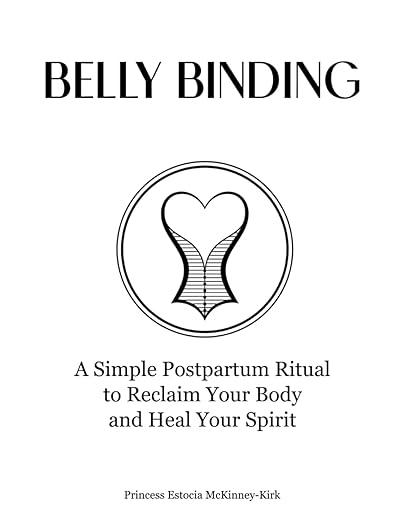Welcoming a child into the world is a transformational experience, but the postpartum road to recovery isn’t always easy. My first child was born via unplanned C-section, and once the pain medications wore off, I remember my body feeling so foreign, like my core strength had disappeared and everything was out of place. All those muscles I relied on to keep me upright and moving around during my pregnancy─gone.
A friend suggested using a belly binder to help with my C-section recovery, and while the idea of wrapping my tender abdomen felt strange, it significantly helped with my ability to move and feel comfortable in my body again.
“Belly binding is an ancient practice that involves wrapping the abdomen with a supportive garment to aid in postpartum recovery,” shares Princess McKinney-Kirk, postpartum doula and CEO of BelliBind. It’s a practice aimed at supporting and nurturing moms, and as McKinney-Kirk points out, it’s resurging as a natural way for new parents to care for their postpartum bodies after any type of birth.
Understanding belly binding
Belly binding is the practice of using a strip of fabric to wrap and support the abdominal area after childbirth. It’s not the same thing as a waist trainer designed to squeeze and reshape the body. Belly binding uses gentle compression to support and aid in healing after giving birth.
McKinney-Kirk likens belly binding to giving your body a warm hug. “Back in the day, belly binding wasn’t just about getting your pre-baby body back [although that’s definitely a perk!],” she explains. “It was all about ritualizing the recovery experience and helping your body heal after the incredible journey of pregnancy and childbirth.”
Ellen Smead, Atlanta-based certified nurse-midwife (CNM), shares that a belly binder comes in all shapes and sizes. “In many cultures around the world, they are often pieces of cotton wrapped in a specific way and tied around the mother securely,” adding that in Western culture, belly binders are made from different fabrics, some with velcro, and are usually adjustable.
The benefits of belly binding are backed by research
McKinney-Kirk says that belly binding is safe and supportive for nearly anyone in the postpartum period, no matter how they delivered, and can be especially healing for those with pelvic floor issues, sciatica, hip instability, or any general discomfort in the abdominal area.
Smead adds that C-section mamas may find belly finding especially helpful. “There is good evidence for postpartum reduction in pain medication use, improved wound healing from the incision site and increased mobility following delivery,” she says.
A 2018 study found that belly binders promoted increased mobility and decreased pain and distress after C-section. Another 2021 meta-analysis found similar results for women post-C-section who experienced significantly less postpartum distress after using abdominal compression.
There’s also something to be said about the ritual of belly binding as an act of love and tenderness towards your postpartum body. “Belly binding can provide emotional support and a sense of security during the delicate post-birth phase as it’s a beautiful act of self-tending and encourages moms to prioritize time to nurture self,” shares McKinney-Kirk.
Belly binding is low risk, but how it fits your body is important
Belly binding appears low-risk and supportive for most women, but it’s always a good idea to check with your midwife or OB-GYN before using it.
If your incision isn’t healing properly or is infected, McKinney-Kirk advises skipping the belly binding until you are fully healed (and still check in with your OB-GYN before use).
The trick is ensuring the right fit. “When using a belly binder, you do want to make sure it is not too restrictive so that you still have plenty of blood flow with good circulation,” says Smead. “Also, make sure it is not irritating an incision scar.”
How to find a belly binding practitioner
One way to ensure the right fit is to work with a practitioner specializing in postpartum belly binding who can guide you on proper use and fit. Smead encourages mamas to ask the birth center, hospital or support groups for recommendations.
While it is possible to do it yourself, having the support and expertise of a professional can give you peace of mind. McKinney-Kirk is proud of her network of trained practitioners offering in-home and virtual support. “Our team ensures optimal self-wrapping techniques for clients, regardless of location.”
Weaving these traditional practices into modern motherhood allows for a holistic approach to postpartum care. “Belly binding isn’t just a thing of the past—it’s a real-life game-changer for modern moms,” says McKinney-Kirk.

Featured experts:
Ellen Smead, CNM, is a certified nurse-midwife at Pediatrix Medical Group in Atlanta, Georgia.
Princess McKinney-Kirk is a postpartum doula, CEO of BelliBind, and author of Belly Binding: A Simple Postpartum Ritual to Reclaim Your Body and Heal Your Spirit.
Sources:
Di Mascio D, Caruso G, Prata G, et al. The Efficacy of Abdominal Binders in Reducing Postoperative Pain and Distress After Cesarean Delivery: A Meta-Analysis of Randomized Controlled Trials. Eur J Obstet Gynecol Reprod Biol. 2021;262:73-79.
Karaca I, Ozturk M, Alay I, et al. Influence of Abdominal Binder Usage after Cesarean Delivery on Postoperative Mobilization, Pain and Distress: A Randomized Controlled Trial. Eurasian J Med. 2019;51(3):214-218.

